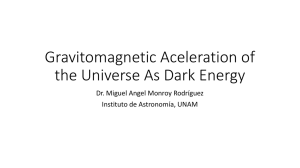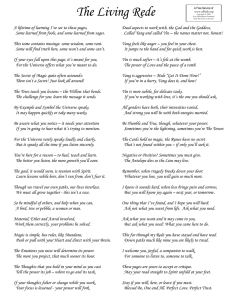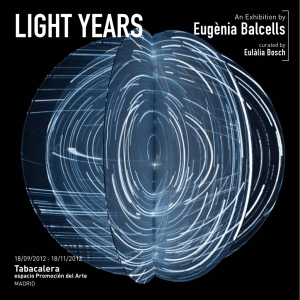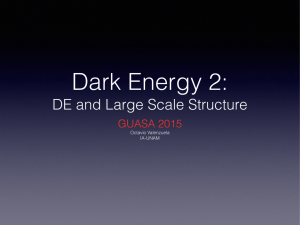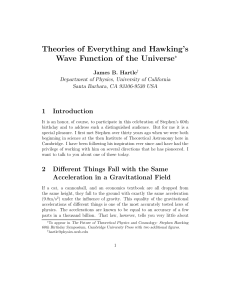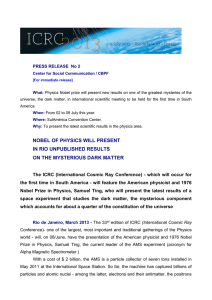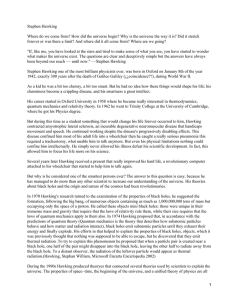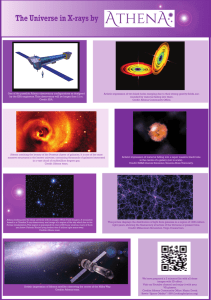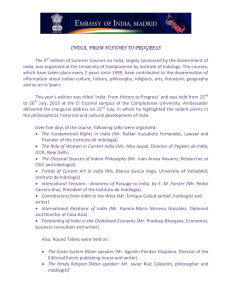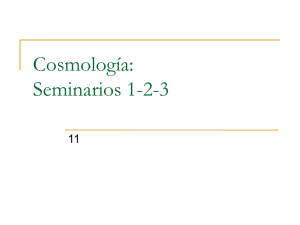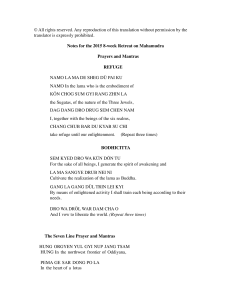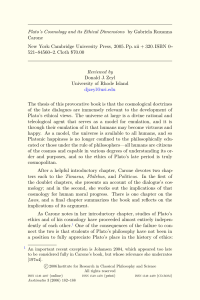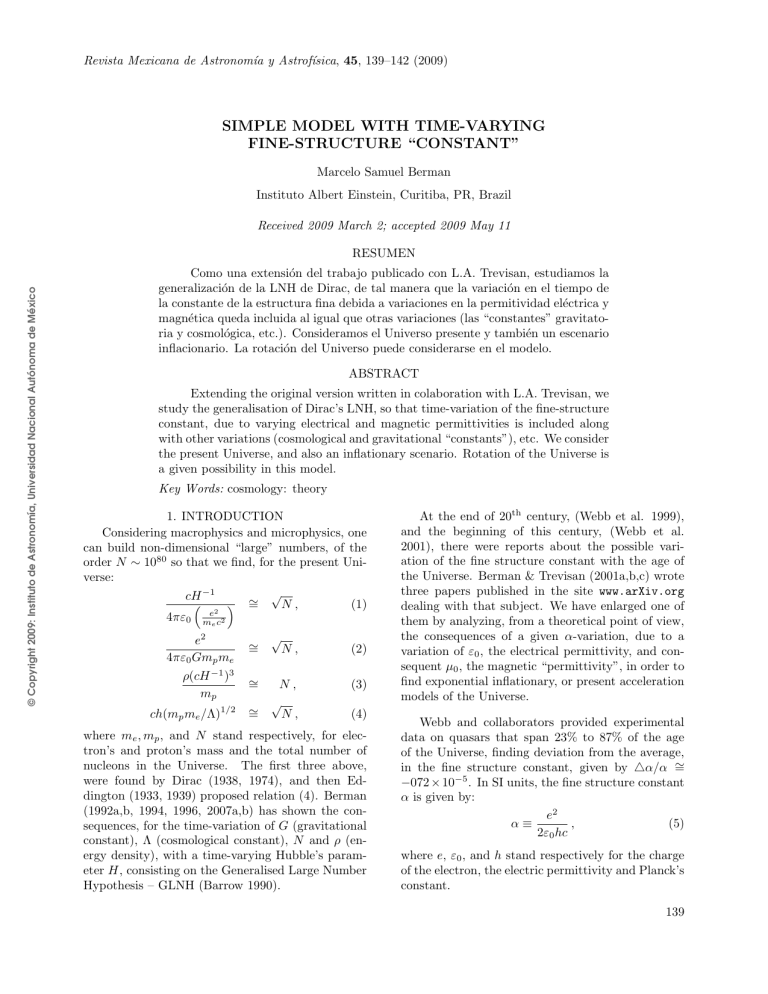
Revista Mexicana de Astronomı́a y Astrofı́sica, 45, 139–142 (2009) SIMPLE MODEL WITH TIME-VARYING FINE-STRUCTURE “CONSTANT” Marcelo Samuel Berman Instituto Albert Einstein, Curitiba, PR, Brazil Received 2009 March 2; accepted 2009 May 11 © Copyright 2009: Instituto de Astronomía, Universidad Nacional Autónoma de México RESUMEN Como una extensión del trabajo publicado con L.A. Trevisan, estudiamos la generalización de la LNH de Dirac, de tal manera que la variación en el tiempo de la constante de la estructura fina debida a variaciones en la permitividad eléctrica y magnética queda incluida al igual que otras variaciones (las “constantes” gravitatoria y cosmológica, etc.). Consideramos el Universo presente y también un escenario inflacionario. La rotación del Universo puede considerarse en el modelo. ABSTRACT Extending the original version written in colaboration with L.A. Trevisan, we study the generalisation of Dirac’s LNH, so that time-variation of the fine-structure constant, due to varying electrical and magnetic permittivities is included along with other variations (cosmological and gravitational “constants”), etc. We consider the present Universe, and also an inflationary scenario. Rotation of the Universe is a given possibility in this model. Key Words: cosmology: theory 1. INTRODUCTION Considering macrophysics and microphysics, one can build non-dimensional “large” numbers, of the order N ∼ 1080 so that we find, for the present Universe: √ cH −1 ∼ N, (1) = 2 4πε0 mee c2 e2 4πε0 Gmp me ∼ = ρ(cH −1 )3 mp ∼ = ch(mp me /Λ)1/2 ∼ = √ N, (2) N, √ N, (3) (4) where me , mp , and N stand respectively, for electron’s and proton’s mass and the total number of nucleons in the Universe. The first three above, were found by Dirac (1938, 1974), and then Eddington (1933, 1939) proposed relation (4). Berman (1992a,b, 1994, 1996, 2007a,b) has shown the consequences, for the time-variation of G (gravitational constant), Λ (cosmological constant), N and ρ (energy density), with a time-varying Hubble’s parameter H, consisting on the Generalised Large Number Hypothesis – GLNH (Barrow 1990). At the end of 20th century, (Webb et al. 1999), and the beginning of this century, (Webb et al. 2001), there were reports about the possible variation of the fine structure constant with the age of the Universe. Berman & Trevisan (2001a,b,c) wrote three papers published in the site www.arXiv.org dealing with that subject. We have enlarged one of them by analyzing, from a theoretical point of view, the consequences of a given α-variation, due to a variation of ε0 , the electrical permittivity, and consequent µ0 , the magnetic “permittivity”, in order to find exponential inflationary, or present acceleration models of the Universe. Webb and collaborators provided experimental data on quasars that span 23% to 87% of the age of the Universe, finding deviation from the average, in the fine structure constant, given by 4α/α ∼ = −072 × 10−5 . In SI units, the fine structure constant α is given by: e2 α≡ , (5) 2ε0 hc where e, ε0 , and h stand respectively for the charge of the electron, the electric permittivity and Planck’s constant. 139 © Copyright 2009: Instituto de Astronomía, Universidad Nacional Autónoma de México 140 BERMAN Due to the fact that α is defined by other constants, one can ask which is the constant that provokes the α variation. Another interesting remark is that this discovery is related to micro and macro phenomena, and can provide the link between Quantum and Classical theories of gravity. Bekenstein (1982) proposed a theory with varying “e”. An alternative theory involves a varying speed of light (Moffat 1993; Albrecht & Magueijo 1999; Barrow 1998; Berman & Trevisan 2001a,b,c; Berman 2007a). We now present the scenario of time varying ε0 while “c”, “h” and “e” are strictly constant. We resort to GLNH. One could claim that a specific gravitational theory is needed in order to make the analysis correct; however, it is not certain at the present time which is the correct theory of gravity that is to be adopted, so our naive analysis can help in visualizing what is going on. If overdots stand for time derivatives, from equation (5) we find that: ε̇0 α̇ =− . α ε0 (6) 2. POWER-LAW VARIATIONS Let us suppose now, tentatively, that ε0 varies with a power law of time, say: ε0 = Atn , (7) with A, n=constants. Then: α̇ = −nt−1 . (8) α On the other hand, the experimental value found by Webb et al. (2001), may be interpreted as: ∆α 0.72 × 10−5 '− ' −1.1 × 10−5 t−1 . α∆t (0.87 − 0.23)t (9) From relations (8) and (9) we find: n ∼ 10−5 . (10) This is the way in which the permittivity has to vary in our framework. From electromagnetism, we know that: c = (ε0 µ0 )−1/2 . (11) In order to keep c=constant, µ0 must vary like (ε0 )−1 . We can check that the following solution applies with Hubble’s parameter proportional to t−1 : N ∝ t2−2n , G ∝ t , ρ ∝ t−1−2n , Λ ∝ −1 t−2+2n . (12) (13) (14) (15) We must remember that n is a very small number; when it is null, we recover the results of Berman’s papers cited above. With the numerical value of n according to relation (10), we would find: N G ρ Λ ∝ t1.99998 , ∝ t−1.0 , ∝ ∝ t−1.00002 , t−1.99998 . (16) (17) (18) (19) Remark 1 We might ask, how can the number of nucleons grow with time, if there should be conservation of baryons in nuclear reactions? The reason is that cosmological phenomena are not ruled by nuclear Physics, and globally, what matters is the conservation of the total energy of the Universe. As the radius grows with time in an expanding Universe, the potential energy grows, while the number of nucleons must also increase, in order that the sum of the latter, with the (negative) potential energy becomes constant. On the other hand, we must remember that the time scale of cosmological growth of N is billions of years, while nuclear reactions proceed in a comparatively instantaneous mode. Remark 2 Relation (17), must be compared with Hubble’s constant. According to the formula, H = −1 [(1 + q) t] , the fact that experimental observations point to the result: Ġ/G < 10−12 per year, only means that the deceleration parameter q for the present Universe should be negative and not much larger than −1. If Hubble’s constant is given by H −1 ∼ = 14 · 109 years, a value like q ≈ −0.95 would yield the desired result, for instance. Remark 3 The present model is also unable to cope with the baryon-anti-baryon asymmetry in the Universe. We suggest that this topic could be eventually related to the rotation of the Universe, which could explain such asymmetry. We hope that the next generation of experimentalists will provide checks on the above results. It is doubtful whether, in the near future, the powers in relations (18) and (19), could be experimentally checked against the obvious laws: ρ ∝ t−1 , Λ ∝ t−2 . Nevertheless, it may happen that the variation law for α, and ε0 could be of major importance in astrophysical or nuclear physics. MODEL WITH TIME-VARYING FINE-STRUCTURE CONSTANT so that, 3. EXPONENTIAL INFLATION We now turn our attention to inflationary scenarios. We remember that in equation (1), the causally related radius, was RU ∼ cH −1 , (20) where H stands for Hubble’s parameter. For exponential inflation, we substitute RU , given by relation (20), as it stands in formula (1) and (3), by R(t) given by, © Copyright 2009: Instituto de Astronomía, Universidad Nacional Autónoma de México R = R(t) = R0 eHt = Aeγt (γ = constant) , ∝ e2(H−γ)t , G ∝ e−Ht , Λ ∝ e−2(H−γ)t , ρ ∝ L = 1093 cm g cm s−1 = 10120 h̄ . (30) We have thus, another large number, L ∝ N 3/2 . (31) h̄ For instance, for the power law, as in standard cosmology, we would have, L ∝ t3(1−n) . (32) For exponential inflation, (R0 , H constants) . (21) The following solution can be checked to fulfill the model, according to relations (1), (2), (3) and (4): ε0 N 141 e−(H+2γ)t . (22) (23) (24) (25) (26) L ∝ e3[H−γ]t (33) We now may guess a possible angular speed of the Universe, on the basis of Dirac’s LNH. For Planck’s Universe, the obvious angular speed would be: c ωP l = ≈ 2 × 1043 s−1 (34) RP l because Planck’s Universe is composed of dimensional combinations of the fundamental constants. In order to get a time-varying function for the angular speed, we recall the Newtonian angular momentum formula, 4. ROTATION OF THE UNIVERSE L = R2 M ω . Remark 4 The purpose of this section, is to show that a time-varying fine-structure constant is compatible with the rotation of the Universe. We have found, from relation (31), that, L ∝ N 3/2 , but we also saw from relation (35) that L ∝ √ ρR5 ω, because R = cH −1 ∝ N and M ∝ ρR3 ∝ N. Then, we find that, Consider the Newtonian definition of angular momentum L, L = RM v , (27) where, R and M stand for the scale-factor and mass of the Universe. For Planck’s Universe, the obvious dimensional combination of the constants h̄, c, and G is, LP l = h̄ . (28) From relations (27) and (28), we see that Planck’s Universe spin takes a speed v = c. For any other time, we take, then, the spin of the Universe as given by L = RM c . (29) In the first place, we take the known values of the present Universe: ω = ω0 t−(1+n) (ω0 = constant) . (35) (36) We are led to admit the following relation: c ω/ , (37) R because n 1. For the present Universe, we shall find, ω / 3 × 10−18 s−1 . (38) It can be seen that the present angular speed is too small to be detected by present technology. For the inflationary model, we carry a similar procedure: 3 N2 (39) ω ∝ 5 = e−[H+γ]t . R ρ The condition for a decreasing angular speed in the inflationary period, is, then, R ≈ 1028 cm , γ > −H . M ≈ 1055 g , For the accelerating power-law case, the condition for decreasing angular speed is n > −1. and, (40) © Copyright 2009: Instituto de Astronomía, Universidad Nacional Autónoma de México 142 BERMAN 5. CONCLUSIONS AND COMMENTS REFERENCES Prior work with a time varying ε0 should be credited to Gomide (1976) who nevertheless worked with α=constant, in face of Bahcall & Schmidt’s paper (1967). We also point out that the origin of c = c(t) theories can be traced to Gomide’s paper (1976) and that the α̇ 6= 0 theories with variable speed of light were also considered several times later by Barrow & Magueijo (see for instance 1999). Albrecht, A., & Magueijo, J. 1999, Phys. Rev. D, 59, 043516 Bahcall, J. N., & Schmidt, M. 1967, Phys. Rev. Lett., 19, 1294 Barrow, J. D. 1998, in 3er RESCEU Symp. on Particle Cosmology, ed. K. Sato, T. Yanagida, & T. Shiromizu (Tokyo: Universal Academic Press), 221 . 1990, in Modern Cosmology in Retrospect, ed. B. Bertotti, R. Balbinot, S. Bergia & A. Messina (Cambridge: Cambridge Univ. Press), 67 Barrow, J. D., & Magueijo, J. 1999, Class. Quantum Grav., 16, 1435 Bekenstein, J. D. 1982, Phys. Rev. D, 25, 1527 Berman, M. S. 1992a, Int. J. Theor. Phys., 31, 1447 . 1992b, Int. J. Theor. Phys., 31, 1217 . 1994, Ap&SS, 215, 135 . 1996, Int. J. Theor. Phys., 35, 1789 . 2007a, Introduction to General Relativity and the Cosmological Constant Problem (New York: Nova Science) . 2007b, Introduction to General Relativistic and Scalar-Tensor Cosmologies (New York: Nova Science) Berman, M. S., & Trevisan, L. A. 2001a, arXiv:grqc/0112011 . 2001b, arXiv:gr-qc/0111102 . 2001c, arXiv:gr-qc/0111101 Dirac, P. A. M. 1938, Proc. Roy. Soc. London A, 165, 199 . 1974, Proc. Roy. Soc. London A, 338, 439 Eddington, A. S. 1933, Expanding Universe (Cambridge: Cambridge Univ. Press) . 1939, Science Progress, 34, 225 Garnavich, P. M., et al. 1998, ApJ, 493, L53 Gomide, F. M. 1976, Lett. Nuovo Cimento, 15, 595 Moffat, J. W. 1993, Int. J. Mod. Phys. D, 2, 351 Perlmutter, S., et al. 1997, ApJ, 483, 565 Perlmutter, S., et al. 1998, Nature, 391, 51 Riess, A. G., et al. 1998, AJ, 116, 1009 Schmidt, B. P., et al. 1998, ApJ, 507, 46 Webb, J. K., Flambaum, V. V., Churchill, Ch. W., Drinkwater, M. J., & Barrow, J. D. 1999, Phys. Rev. Lett., 82, 884 Webb, J. K., et al. 2001, Phys. Rev. Lett., 87, 091301 Our results are compatible with the experimental result that the Universe would be accelerating, as supernovae results confirmed. (Perlmutter et al. 1997, 1998; Garnavich et al. 1998; Schmidt et al. 1998; Riess 1998; etc.). We have shown that GLNH, the fine structure constant time variation, the accelerating Universe, the variable lambda or variable permittivity, are all coherent among them. Rotation of the Universe was shown, as a possibility, either for power-laws, or exponential variation of the “radius of the Universe”. The “non-rotation” condition for inflationary scenarios is given by γ = −H, and for the present Universe n = −1. These conditions are out of question from the experimental side. One final comment remains necessary: it will be the task of a Superunification theory to explain this or other time variation of fundamental constants. We employed the GLNH hypothesis tentatively, we just wait that some gravitational theory may be found to apply better than our present approach. The author thanks the referee for important suggestions, which were included in the final version. Thanks also to the author’s intellectual mentors, Fernando de Mello Gomide and the late M. M. Som, and to Marcelo Fermann Guimarães, Nelson Suga, Mauro Tonasse, Antonio F. da F. Teixeira, and to Albert, Paula and Geni, for encouragement. Marcelo Samuel Berman: Instituto Albert Einstein, Av. Candido Hartmann, 575, No. 17, 80730-440, CuritibaPR, Brazil ([email protected]).
